Annals of Emergency Medicine
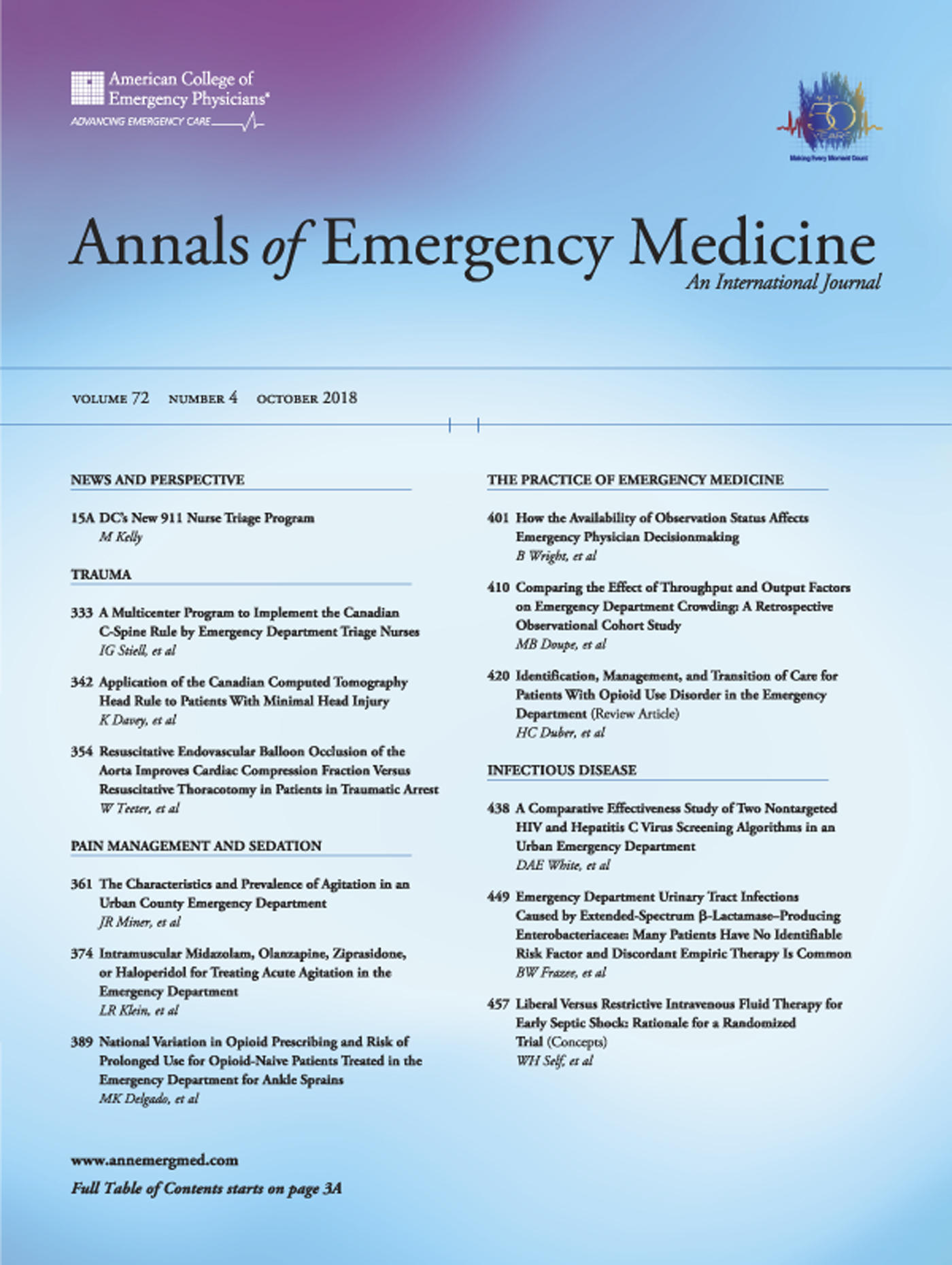
Official journal of the American College of Emergency Physicians
(The print version of this article has been scheduled for January 2019)
Abscess Incision and Drainage With or Without Ultrasonography: A Randomized Controlled Trial
Romolo J. Gaspari, Alexandra Sanseverino, Timothy Gleeson
https://doi.org/10.1016/j.annemergmed.2018.05.014
Study objective: We hypothesize that clinical failure rates will be lower in patients treated with point-of-care ultrasonography and incision and drainage compared with those who undergo incision and drainage after physical examination alone.
Methods: We performed a prospective randomized clinical trial of patients presenting with a soft tissue abscess at a large, academic emergency department. Patients presenting with an uncomplicated soft tissue abscess requiring incision and drainage were eligible for enrollment and randomized to treatment with or without point-of-care ultrasonography. The diagnosis of an abscess was by physical examination, bedside ultrasonography, or both. Patients randomized to the point-of-care ultrasonography group had an incision and drainage performed with bedside ultrasonographic imaging of the abscess. Patients randomized to the non–point-of-care ultrasonography group had an incision and drainage performed with physical examination alone. Comparison between groups was by comparing means with 95% confidence intervals. The primary outcome was failure of therapy at 10 days, defined as a repeated incision and drainage, following a per-protocol analysis. Multivariate analysis was performed to control for study variables. Our study was designed to detect a clinically important difference between groups, which we defined as a 13% difference.
Results: A total of 125 patients were enrolled, 63 randomized to the point-of-care ultrasonography group and 62 to physical examination alone. After loss to follow-up and misallocation, 54 patients in the ultrasonography group and 53 in the physical examination alone group were analyzed. The overall failure rate for all patients enrolled in the study was 10.3%. Patients who were evaluated with ultrasonography were less likely to fail therapy and have repeated incision and drainage, with a difference between groups of 13.3% (95% confidence interval 0.0% to 19.4%). Abscess locations were predominantly torso (21%), buttocks (21%), lower extremity (18%), and axilla or groin (16%). There was no difference in baseline characteristics between groups relative to abscess size, duration of symptoms before presentation, percentage with cellulitis, and treatment with antibiotics.
Conclusion: Patients with soft tissue abscesses who were undergoing incision and drainage with point-of-care ultrasonography demonstrated less clinical failure compared with those treated without point-of-care ultrasonography.
How to cite this article:
Gaspari, RJ, Sanseverino, A, Glesson, T. Abscess Incision and Drainage With or Without Ultrasonography: A Randomized Controlled Trial. 2018.
African journal of emergency medicine
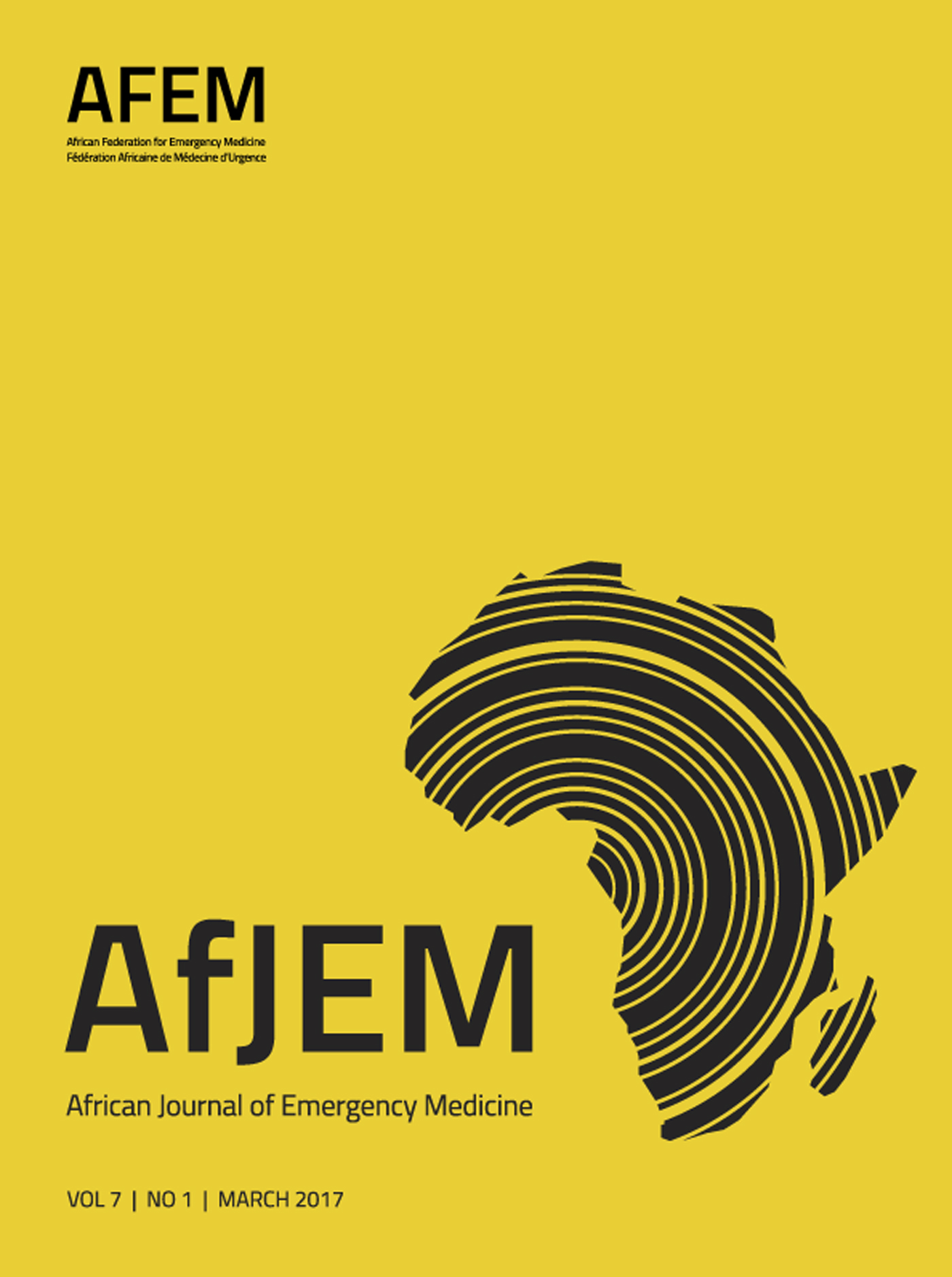
The official journal of the African Federation for Emergency Medicine, the Emergency Medicine Association of Tanzania, the Emergency Medicine Society of South Africa, the Egyptian Society of Emergency Medicine, the Libyan Emergency Medicine Association, the Ethiopian Society of Emergency Medicine Professionals, the Sudanese Emergency Medicine Society, the Society of Emergency Medicine Practitioners of Nigeria and the Rwanda Emergency Care Association
African Federation for Emergency Medicine’s Francophone Working Group – May 2018 Report
Mundenga MM, Diango K, Mbanjumucyo G, Kabongo D, Tenner AG
Afr J Emerg Med 2018;8(3):123-5.
https://doi.org/10.1016/j.afjem.2018.08.003
Introduction: Even though the African Federation for Emergency Medicine (AFEM) has been successfully developing emergency care in Africa for the past nine years, a considerable amount of potential AFEM members from the African-Francophone countries are not able to access AFEM resources. In response, an AFEM Francophone Working Group has been created to coordinate all existing and new initiatives to promote emergency care in African-Francophone countries.
Challenges that led to the creation of AFEM’s Francophone Working Group
In less than ten years, AFEM has succeeded in gathering more than 2000 people in over 25 countries across Africa. These members now have the opportunity to improve their local and regional emergency care capacity through AFEM resources, including biannual AFEM conferences, AFEM’s educational materials and AFEM leadership.
Unfortunately, when compared to the African-English speaking countries, French-speaking countries have been underrepresented in the past three biannual AFEM conferences held in Ghana (2012), Ethiopia (2014), and Egypt (2016). They have been unable to make use of AFEM’s educational resources due to the language barrier as almost all of AFEM’s educational materials are in English, and AFEM representation in French-speaking countries is almost non-existent. Furthermore, none of the nine African emergency medicine societies have a French training programme.
The role of AFEM’s Francophone Working Group
The AFEM’s Francophone Working Group’s main goal is to help accomplish AFEM’s priorities; that is, to increase membership and awareness, to increase presence in Francophone and North African countries, to increase advocacy activities, to develop AFEM regional groups and in-country presence, and to promote acute care research and the development of African clinician researchers.
Having an AFEM-Francophone section is crucial to increasing AFEM’s Francophone membership, coordinating all Francophone initiatives, helping with the AFEM material translation to French, and ensuring that standards of training in emergency care and research in emergency medicine are provided according to AFEM’s goals and vision.
Reproduced with permission.
Emergency Medicine Journal
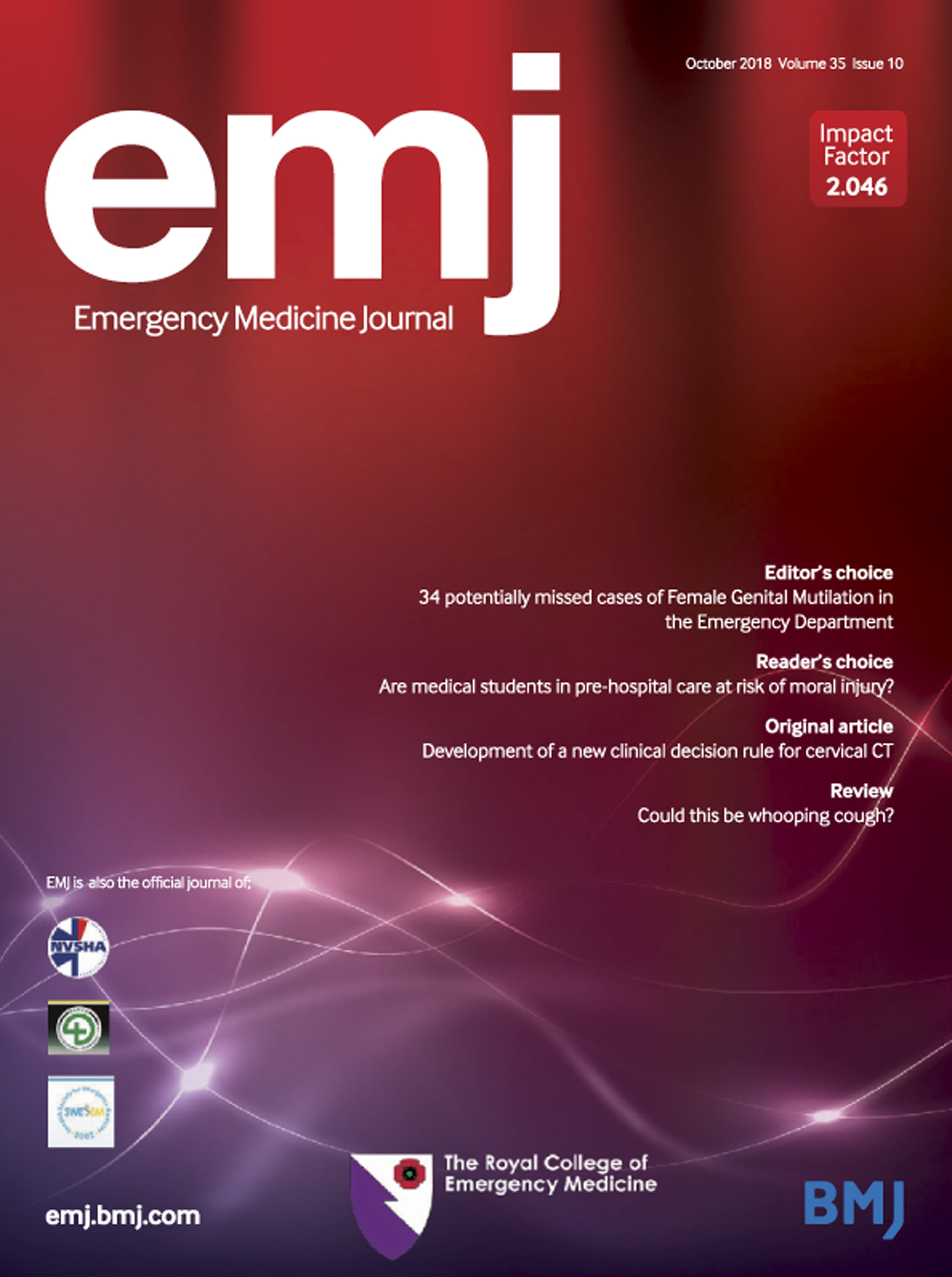
Official Journal of the Royal College of Emergency Medicine
Understanding better how emergency doctors work. Analysis of distribution of time and activities of emergency doctors: a systematic review and critical appraisal of time and motion studies
Maysam Ali Abdulwahid, Andrew Booth, Janette Turner, Suzanne M Mason Published Online First: 05 September 2018.
https://doi.org/10.1136/emermed-2017-207107
Background: Optimising the efficiency and productivity of senior doctors is critical to ED function and delivery of safe patient care. Time and motion studies (TMS) can allow quantification of how these doctors spend their working time, identify inefficiencies in the current work processes and provide insights into improving working conditions, and enhancing productivity. Three questions were addressed: (1) How do senior emergency doctors spend their time in the ED? (2) How much of their time is spent on multitasking? (3) What is the number of tasks completed per hour?
Methods: The literature was systematically searched for TMS of senior emergency doctors. We searched for articles published in peer-reviewed journals in English language from 1998 to 2018 in the following databases: MEDLINE, EMBASE, Scopus, Web of Science and Cochrane. Studies were assessed for methodological quality using evidence-based quality criteria relevant for TMS including duration of observation, observer bias, Hawthorne effect and whether the task classification acknowledged any previous existing schemes. A narrative synthesis approach was followed.
Results: Fourteen TMS were included. The studies were liable to several biases including observer and Hawthorne bias. Overall, the time spent on direct face-to-face contact with the patient accounted for at least around 25%–40% of the senior doctors’ time. The remaining time was mostly spent on indirect clinical care such as communication (8%–44%), documentation (10%–28%) and administrative tasks (2%–20%). The proportion of time spent on multitasking ranged from 10% to 23%. When reported, the number of tasks performed per hour was generally high.
Conclusion: The review revealed that senior doctors spent a large percentage of their time on direct face-to-face contact with patients. The review findings provided a grounded understanding of how senior doctors spent their time in the ED and could be useful in implementing improvements to the emergency care system.
Emergencias
http://emergencias.portalsemes.org/English
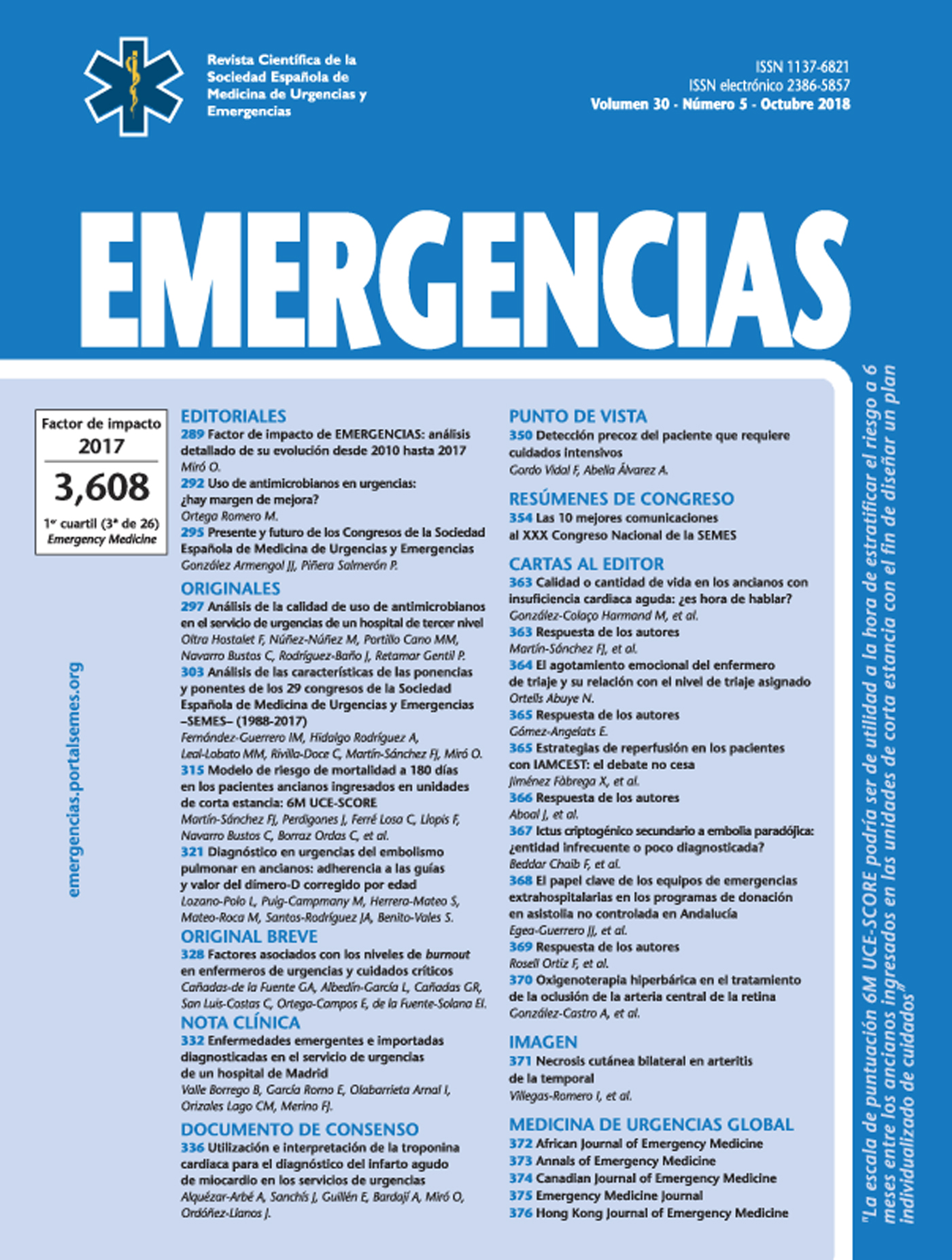
Official Journal of the Spanish Society of Emergency Medicine
Presentations at 29 conferences of the Spanish Society of Emergency Medicine (SEMES) from 1988 to 2017: a descriptive analysis
Inés María Fernández-Guerrero, Abraham Hidalgo-Rodríguez, María de las Mercedes Leal-Lobato, Celia Rivilla-Doce, F. Javier Martín-Sánchez, Òscar Miró.
Cited: Fernández-Guerrero IM, Hidalgo-Rodríguez A, Leal-Lobato MM, Rivilla-Doce C, Martín-Sánchez FJ, Miró O. Presentations at 29 conferences of the Spanish Society of Emergency Medicine (SEMES) from 1988 to 2017: a descriptive analysis. Emergencias. 2018;30:303-14.
Objective: To gain greater understanding of the development of emergency medicine in Spain by analyzing the presentations at conferences of the Spanish Society of Emergency Medicine (SEMES) over the past 30 years (1988–2017).
Methods: We examined the programs of all SEMES conferences and described the characteristics of both presentations and presenters. We also analyzed changes occurring between 1988 and 2017 of some of the characteristics observed. The Web of Science was searched to evaluate the scientific productivity of the most frequent presenters and to calculate h-indexes for those presenters to assesstheir scientific relevance.
Results: SEMES did not hold a conference in 1992. The total of 29 conferences included 2182 presentations (112 listing presenters from abroad) given by 1410 presenters (89 from abroad). The presenters’ affiliations named 616 centers. The number of presentations and presenters increased linearly during the first period and then leveled off. The number increased exponentially in the final phase. Men gave 79.6% of the presentations; 70.6% of the presenters were physicians, 11.9% were nurses and 4.0% were ambulance staff. Specialists in emergency medicine accounted for 60.8% of the presenters who were physicians. Presenters from the Spanish autonomous community organizing the conference gave 29.8% of the presentations. The contributions of presenters from the local organizing community were nearly always more numerous than the average number of contributions from that community in all 29 conferences overall. Conference contributions from some autonomous communities (Extremadura, Andalusia, and Catalonia) were considerably fewer than would be expected given the scientific productivity of those communities. However, communities (Murcia, Balearic Islands, Asturias, Castile-Leon, Madrid), gave many more presentations tan their productivity metrics would predict. Analysis of the 59 most frequent presenters (at 5 conferences or more) showed that 64.4% of them had published at least 20 articles and that 71.2% had an h-index of 5 or higher. The number of women on the program increased significantly between 1988 and 2017. Likewise, geographic diversity increased significantly (presentations from centers outside the local organizing area) as did the participation of hospitalbased emergency medicine specialists.
Conclusions: SEMES conference programs have attracted significantly more presentations and presenters over the years. We also detected changes in descriptive characteristics. The analysis of those characteristics can help future SEMES conference planners to plan ways to correct aspects such as scarce geographic diversity, low international participation, and few women among presenters.
Hong Kong Journal of Emergency Medicine
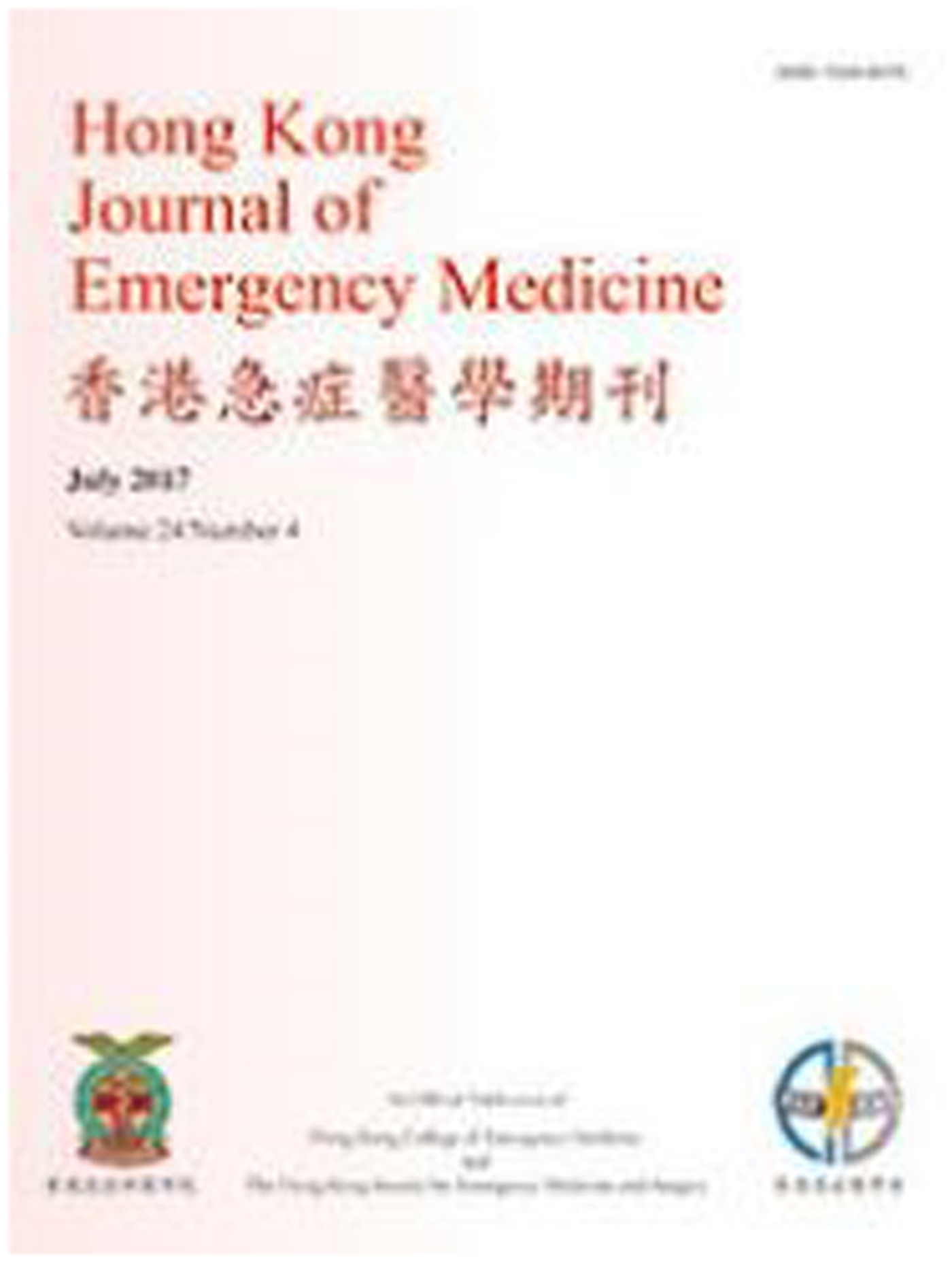
Official Journal of the Hong Kong College of Emergency Medicine
The significance of National Early Warning Score for predicting prognosis and evaluating conditions of patients in resuscitation room
Wang Chang Yuan, Cao Tao, Zhu Dan Dan, Sun Chang Yi, Wang Jing and Qin Jian
Background: For critical patients in resuscitation room, the early prediction of potential risk and rapid evaluation of disease progression would help physicians with timely treatment, leading to improved outcome. In this study, it focused on the application of National Early Warning Score on predicting prognosis and conditions of patients in resuscitation room. The National Early Warning Score was compared with the Modified Early Warning Score) and the Acute Physiology and Chronic Health Evaluation II.
Objectives: To assess the significance of NEWS for predicting prognosis and evaluating conditions of patients in resuscitation rooms.
Methods: A total of 621 consecutive cases from resuscitation room of Xuanwu Hospital, Capital Medical University were included during June 2015 to January 2016. All cases were prospectively evaluated with Modified Early Warning Score, National Early Warning Score, and Acute Physiology and Chronic Health Evaluation II and then followed up for 28 days. For the prognosis prediction, the cases were divided into death group and survival group. The Modified Early Warning Score, National Early Warning Score, and Acute Physiology and Chronic Health Evaluation II results of the two groups were compared. In addition, receiver operating characteristic curves were plotted. The areas under the receiver operating characteristic curves were calculated for assessing and predicting intensive care unit admission and 28-day mortality.
Results: For the prognosis prediction, in death group, the National Early Warning Score (9.50±3.08), Modified Early Warning Score (4.87±2.49), and Acute Physiology and Chronic Health Evaluation II score (23.29±5.31) were significantly higher than National Early Warning Score (5.29±3.13), Modified Early Warning Score (3.02±1.93), and Acute Physiology and Chronic Health Evaluation II score (13.22±6.39) in survival group (p<0.01). For the disease progression evaluation, the areas under the receiver operating characteristic curves of National Early Warning Score, Modified Early Warning Score, and Acute Physiology and Chronic Health Evaluation II were 0.760, 0.729, and 0.817 (p<0.05), respectively, for predicting intensive care unit admission; they were 0.827, 0.723, and 0.883, respectively, for predicting 28-day mortality. The comparison of the three systems was significant (p<0.05).
Conclusion: The performance of National Early Warning Score for predicting intensive care unit admission and 28-day mortality was inferior than Acute Physiology and Chronic Health Evaluation II but superior than Modified Early Warning Score. It was able to rapidly predict prognosis and evaluate disease progression of critical patients in resuscitation room.




